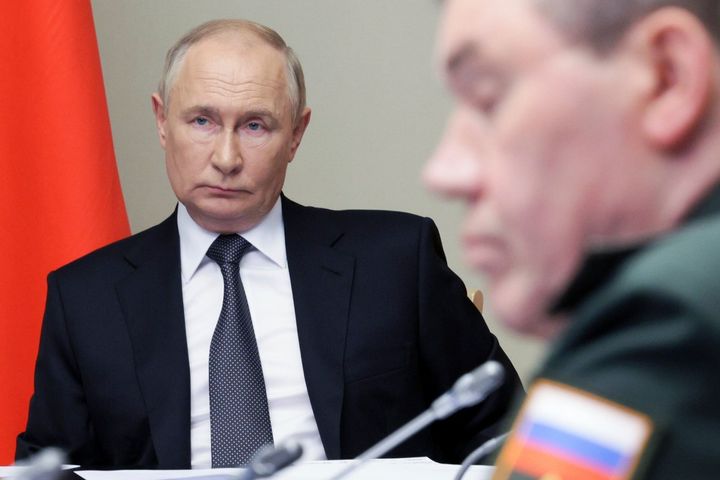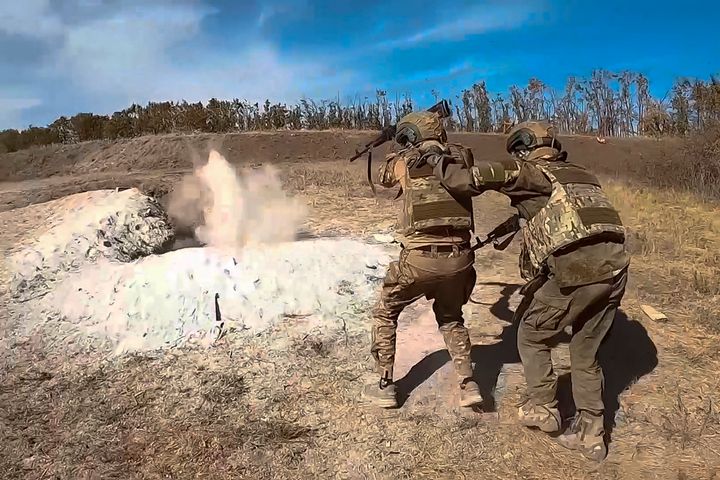
Two months ago, Ukrainian troops shocked its allies – and enemies – by invading Russia, marking the first time since since World War 2 that a foreign force had occupied its land.
It was a stunning way to turn the tables on Vladimir Putin, who has occupied around 18% – just over 100,000 sq km – of Ukrainian land for the best part of the last two and a half years.
It was quite a feat and made headlines around the world but, as HuffPost UK understands, Western officials were not expecting it to last.
While the 1,000 sq km land grab in Kursk was seen as a huge morale boost to the beleaguered Ukrainian troops, the Kremlin was expected to quash it with an iron fist.
Even though Kyiv forces have achieved some noteworthy victories on the Ukrainian frontline, it was thought that the Russian army – which Statista reports has at least 400,000 more active soldiers than its opponents – would overpower the Ukrainians, especially on their own territory.
In fact, Western officials believed it was “inevitable” the Ukrainian troops would be forced out of Kursk pretty quickly.
But within the first week, as many as 180,000 Russian civilians had been evacuated from the area, and there was no significant sign that the Ukrainian troops were about to be removed.

Putin himself barely acknowledged the “events” unfolding in Western Russia but did look pretty uneasy about the incursion in televised meetings with his security officials.
He eventually roused himself and, on September 11, Putin vowed his troops would remove the Ukrainian forces entirely by October 1.
His words left Western insiders “worried” that Russia would retaliate as soon as it had the right command and control in place.
But, a source told HuffPost UK earlier this week: “So far, they’ve not succeeded, which is slightly against our initial expectations.”
They noted that Putin’s plan to resolve the “humiliation of losing Russian sovereign territory” has not been “terribly effective”.
To further hammer home the Kremlin’s inaction, reports seized by the Ukrainians and published by the Guardian last month claimed Russia was aware of the Kursk incursion a long time in advance – possibly since late 2023. But Moscow did nothing.

US officials told the New York Times in August that Russia probably needs at least 50,000 troops to oust the Ukrainians.
Instead, Russia is relying on an estimated 38,000 poorly trained conscripts to fight in Kursk while its more experienced soldiers are trying to gain ground in Ukraine’s Donbas region.
Putin appears happy enough to keep it that way – after all, it means sticking to the Kremlin’s promise not to deploy conscripts to the frontline in Ukraine but still means they are helping the war effort.
These battalions are not exactly being very effective, though, and are reportedly attacking settlements in Kursk with no Ukrainian troops present, according to Kyiv’s military.
A Ukrainian spokesperson, Vadym Mysnyk, said: “The local population doesn’t understand why they are being hit [by Russian forces] because the [Ukrainian] military is not even nearby.
“But the locals are suffering, they are forced to hide in basements for several hours and sometimes spend half a day there.”
Western officials also suggested to HuffPost UK that Putin’s reluctance to use any troops other than conscripts comes down to an unwillingness to mobilise over fear of backlash from the Russian public.
Putin’s most high-profile attempt to call up reservists backfired spectacularly in September 2022.
After taking heavy losses on the battlefield, he called 300,000 people up to serve, sparking a wave of protests suggesting Putin should be sent “to the trenches” and prompting many eligible Russians to flee the country.
Two years later, backlash over the frontline has not completely stopped – relatives of soldiers on the frontline have tried to lobby Putin and his ministers to return the battle-worn troops, but to no avail.
The disaster in Kursk is also having a knock-on effect for Russian forces in Ukraine.
The US-based think tank, the Institute for the Study of War (ISW), claimed on Friday that the incursion had “significantly complicated the development of Russia’s operational reserves”.
Ukrainian president Volodymyr Zelenskyy told the New Yorker in September: “It has slowed down the Russians and forced them to move some of their forces to Kursk on the order of 40,000 troops. Already, our fighters in the east say that they are being battered less frequently.
“I’m not saying it’s a resounding success or will bring about the end of the war or the end of Putin. What it has done is show our partners what we’re capable of.”
This impact on the Ukrainian frontline will likely continue until Putin “decides that the benefits of more effective force-generation policies, such as another partial mobilisation call up of Russian reservists, outweigh the risk of societal backlash”, according to the ISW.

Western officials also said that “much to [their] surprise”, they realised in the early stages of the war that Russian kit was not as good as expected – while Ukraine has been innovative with its own weaponry.
“Russia just took a long time to learn lessons and to adapt and evolve in the way they were fighting,” an insider said.
They summarised that it’s a “much more level playing field” now, and it’s hard to say who “has the upper hand” between the two warring countries.
The president is pre-occupied by the state of the economy, too. He has just increased defence spending in Russia by 25%, but cut 15% in social needs and kept a very high interest rate in place.
A source told HuffPost UK: “One of the reasons he’s worried about mobilising is that he will take further manpower, labour, out of the market.”
Still, there is no doubt that there will be domestic downsides to this inaction, as even Russian voices are speaking up.
Political analyst Sergei Mikheyev told Russian state TV in August: “It leads to demobilisation and international demotivation. There needs to be an understanding that time is of the essence.”
The Kursk incursion appears to have changed the war in two not insignificant ways; boosting Ukraine’s morale, and dampening Russia’s.
And, as the president’s indecision over the offensive looks likely to allow the long-term impacts of the Ukrainian offensive to play out, only time will tell just how much it damages Putin.
